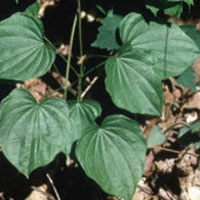Wild Yam
 © Steven Foster
© Steven FosterParts Used & Where Grown
Wild yam plants are found across the midwestern and eastern United States, Latin America (especially Mexico), and Asia. A few different species exist. All of which possess similar constituents and properties. The root is used medicinally.
- Reliable and relatively consistent scientific data showing a substantial health benefit.
- Contradictory, insufficient, or preliminary studies suggesting a health benefit or minimal health benefit.
- For an herb, supported by traditional use but minimal or no scientific evidence. For a supplement, little scientific support.
Our proprietary “Star-Rating” system was developed to help you easily understand the amount of scientific support behind each supplement in relation to a specific health condition. While there is no way to predict whether a vitamin, mineral, or herb will successfully treat or prevent associated health conditions, our unique ratings tell you how well these supplements are understood by the medical community, and whether studies have found them to be effective for other people.
For over a decade, our team has combed through thousands of research articles published in reputable journals. To help you make educated decisions, and to better understand controversial or confusing supplements, our medical experts have digested the science into these three easy-to-follow ratings. We hope this provides you with a helpful resource to make informed decisions towards your health and well-being.
This supplement has been used in connection with the following health conditions:
| Used for | Amount | Why |
|---|---|---|
Elevated Cholesterol | Refer to label instructions | Wild yam does not appear to impact lipid profiles. |
Menopause | Refer to label instructions | Wild yam is a herb with weak oestrogen-like actions similar to soya. In one trial, a formula containing liquorice, burdock, dong quai, wild yam, and motherwort reduced menopause symptoms. |
Traditional Use (May Not Be Supported by Scientific Studies)
Wild yam has been used by herbalists as an expectorant for people with coughs. It was also used for gastro-intestinal upset, nerve pain, and morning sickness.1 Eventually, it was discovered that the saponins from wild yam could be converted industrially into cortisone, estrogens, and progesterone-like compounds. Wild yam and other plants with similar constituents continue to be a source for these drugs.
Copyright © 2024 TraceGains, Inc. All rights reserved.
Learn more about TraceGains, the company.
The information presented by TraceGains is for informational purposes only. It is based on scientific studies (human, animal, or in vitro), clinical experience, or traditional usage as cited in each article. The results reported may not necessarily occur in all individuals. Self-treatment is not recommended for life-threatening conditions that require medical treatment under a doctor's care. For many of the conditions discussed, treatment with prescription or over the counter medication is also available. Consult your doctor, practitioner, and/or pharmacist for any health problem and before using any supplements or before making any changes in prescribed medications. Information expires December 2024.



 We are proud to announce that
We are proud to announce that  As the market evolves, customers increasingly request a wider variety of omega-3 options for their lipid...
As the market evolves, customers increasingly request a wider variety of omega-3 options for their lipid...  Maintaining healthy glucose levels is crucial for preventing metabolic conditions like diabetes,...
Maintaining healthy glucose levels is crucial for preventing metabolic conditions like diabetes,...  Looking at formulating a new vitamin blend? Discover
Looking at formulating a new vitamin blend? Discover 







































